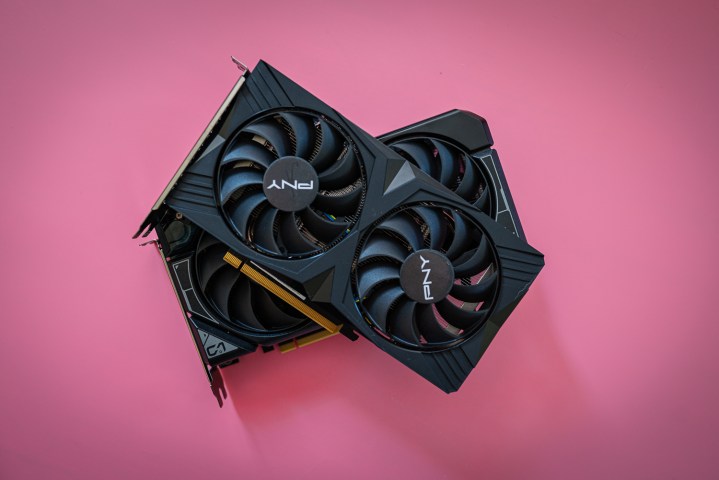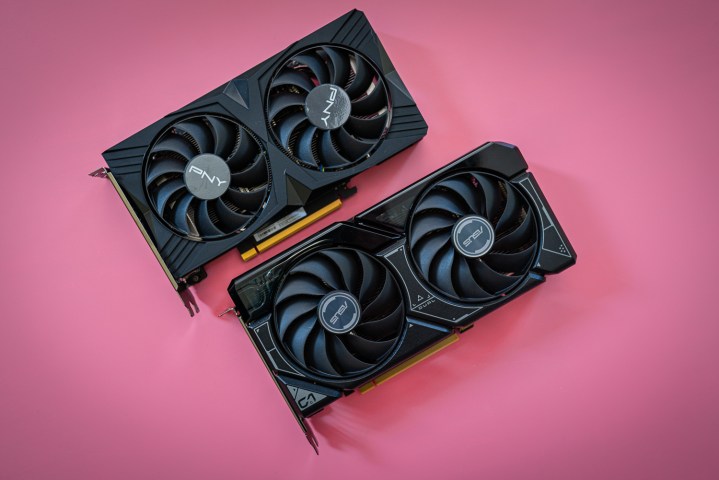Intel is back with one of the best graphics cards you can buy — the Arc B580. As you can read in my Intel Arc B580 review, it’s a graphics card that has no business being as powerful as it is given how inexpensive it is. And when comparing it to its main competitor, Nvidia’s RTX 4060, Intel mops the floor with its rival.
I’ve been testing Intel’s latest GPU over the last couple of weeks, and I decided to put it head-to-head with Nvidia’s budget RTX 4060, which is currently the second-most-popular GPU on Steam. Given the performance I’ve seen, Intel’s GPU deserves to start climbing up the rankings in those same charts.
Specs and pricing

When comparing two different architectures from two different brands, it’s important to not draw too many conclusions based on specs alone. Intel is using its Battlemage architecture, and Nvidia its Ada Lovelace architecture, and these two designs scale differently in terms of core count and react differently to clock speed.
There are two main specs that we can compare between these GPUs, and both are important. First, power. The Arc B580 is configured like a lowe- midrange graphics cards in many respects, and it comes with a design capable of 190 watts to match. The RTX 4060, on the other hand, tops out at 115W. There’s no doubt that the RTX 4060 is more efficient, but both GPUs still only require a single 8-pin power connector.
The more important difference is VRAM. The Arc B580 comes with 12GB of GDDR6 memory, while the RTX 4060 is locked to 8GB of GDDR6 memory. Moreover, Intel is using a 192-bit bus while Nvidia is using a 128-bit bus. Not only does the Arc B580 have higher memory capacity, but it also has higher bandwidth that helps it account for the small amount of cache available on the RTX 4060.
| Arc B580 | RTX 4060 | |
| Architecture | Battlemage | Ada Lovelace |
| Process node | TSMA N5 | TSMC N4 |
| Ray tracing cores | 20 | 24 (3rd-gen) |
| Tensor/XMX cores | 160 | 96 (4th-gen) |
| Boost clock speed | 2.67GHz | 2.46GHz |
| VRAM | 12GB GDDR6 | 8GB GDDR6 |
| Bus width | 192-bit | 128-bit |
| Total Graphics Power (TGP) | 190W | 115W |
| Price | $249 | $299 |
The death of 8GB GPUs has been a slow and painful one, but we’re starting to see the saga come to a close with games like Indiana Jones and the Great Circle. Titles like this can stress 8GB graphics cards, even at 1080p. Although graphics cards aren’t solely defined by their VRAM — most titles run just fine with 8GB, particularly at 1080p — you’ll appreciate the extra capacity on the Arc B580 when games like Indiana Jones roll around.
It’s easy to justify the extra VRAM, too, because it doesn’t come at an additional cost. In fact, the Arc B580 is a bit cheaper than the RTX 4060. The RTX 4060 has a list price of $300, and most models still sell around that price. Overclocked versions reach up to $330, while models on sale occasionally drop to around $290. But overall, you should expect to spend about $300 on an RTX 4060.
The Arc B580, meanwhile, retails for $250. That’s the price set by Intel, though it’s hard to say what the price will be at retailers in the coming weeks. The Arc B580 just launched, and given its surprisingly capable performance, it could end up being a popular GPU. If that’s the case, prices could rise up to $300, though I don’t imagine they’ll go beyond that point. If you can get your foot in the door early, however, you’ll save $50 compared to the RTX 4060.
Gaming performance

Both the Arc B580 and RTX 4060 are 1080p graphics cards, but with a few graphics tweaks and the assistance of DLSS or XeSS, you can push them to 1440p. Above, you can see the benchmarks I ran for 1080p. The results here were gathered on the same day on the exact same test bench, and I used the highest graphics preset available without upscaling (except for Black Myth: Wukong, which I ran at 68% resolution scale).
It’s a one-sided battle here, with Intel taking the lead. If you account for ray tracing, which I’ll get into next, the Arc B580 comes out a clean 9% ahead of the RTX 4060. There are some games where the two cards are close, such as Black Myth: Wukong and Assassin’s Creed Mirage, but the Arc B580 absolutely crushes its opponent in titles like Cyberpunk 2077, Returnal, and Horizon Zero Dawn Remastered.
The RTX 4060 claims a couple of significant wins, including in Call of Duty Modern Warfare 2. The Arc B580 seriously struggles in this title across resolutions. Then there’s Dying Light 2. Nvidia clearly wins in this game at 1080p, but the Arc B580 seems to have an issue with this particular title at that resolution.

You can see how the script flips in Dying Light 2 at 1440p. Intel’s architecture scales better to higher resolutions, which isn’t solely to do with the VRAM capacity. The Arc B580 claims a lead at this resolution in every title I tested, short of Call of Duty Modern Warfare 2.
Once you factor in ray tracing, the Arc B580 ends up 18% ahead of the RTX 4060 at 1440p, which is a massive gap. It’d be one thing if these two GPUs were close, but they’re not. Intel is offering better performance and a lower price with the Arc B580, which is seriously impressive.
Ray tracing performance

Nvidia normally dominates ray tracing performance, but the Arc A770 and A750 proved that Intel has ray tracing chops, too. The Arc B580 puts that on full display. In the three titles I tested, the Arc B580 claimed a lead at 1080p, as you can see above, and sometimes by a solid margin.
The same was true at 1440p, and just like rasterized performance, the Arc B580 has an even wider margin over the RTX 4060. The Arc B580 is more powerful than the RTX 4060, but when it comes to ray tracing, that extra VRAM capacity certainly helps a lot as well.

However, it’s not all upside for Intel. One game missing here is Black Myth: Wukong, which would consistently crash with path tracing enabled on the Arc B580. Intel has already addressed the issue, but it speaks to a wider concern with Intel GPUs. Although the Arc B580 is fantastic, Intel’s discrete graphics business is still relatively young, and there sometimes are games where the cards show odd performance and bugs.
The situation isn’t nearly as bad as it was with Intel’s first generation, and I suspect that most users will never run into serious issues. However, Intel hasn’t worked out all of the kinks with its graphics software yet, so there are occasionally games where you see minor issues like this. Thankfully, these types of problems are usually addressed within a matter of days with a new driver.
DLSS and XeSS

A big aspect of modern GPUs is upscaling, and Intel and Nvidia both have big tools on that front. For Nvidia, it’s DLSS 3. This gets you upscaling in hundreds of games, a good chunk of which also support DLSS Frame Generation. A select few titles like Cyberpunk 2077 and Alan Wake 2 support Nvidia’s Ray Reconstruction as well, though the RTX 4060 usually isn’t powerful enough to take advantage of that feature.
DLSS is really the gold standard for both upscaling and frame generation, not only because it looks and performs excellently, but also because it’s available in so many games. Nvidia aggressively pushes its new features, and that means you have hundreds of popular titles with DLSS support.
Intel has its XeSS, which is also very good. The Arc B580 supports XeSS 2, which mirrors the DLSS 3 package with both upscaling and frame generation, but it’s only available in a single title right now — F1 24. Intel has done good work to pick up adoption of XeSS, though it’s sill a good wasy behind Nvidia.
XeSS can match DLSS’ quality and performance, but the main thing holding it back is adoption. In some games with the Arc B580, you’ll have to resort to using AMD’s FSR when XeSS isn’t available. That’s the one major trade-off when it comes to the Arc B580.
One-sided win

The headline here is better performance and a lower price. The Arc B580 handily wins this comparison, not only matching the RTX 4060, but often showcasing much better performance with its larger VRAM capacity. The fact that it’s $50 cheaper is just the cherry on top.
Time will tell if XeSS 2 adoption ramps up more aggressively than the first version did, but that’s the one major drawback of the Arc B580 right now. DLSS 3 is available in a ton of games, and it largely justifies the sometimes mediocre performance of the RTX 4060. Thankfully, Intel is offering enough with the Arc B580 to overcome its disadvantage on the upscaling and frame-generation front.





